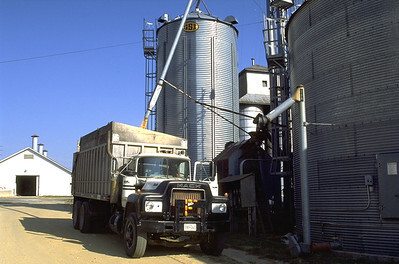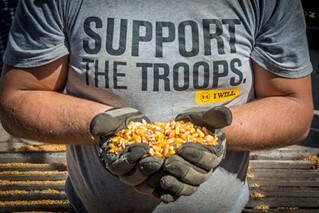
June is “Dairy Month” so it gives us an opportunity to salute America’s dairy farmers across the State of Indiana. Thank you for the work you do – day in and day out – to provide wholesome, nutritious, and fresh products to our dining room tables, every single day. It also gives us a chance to look forward to the Dairy Bar at the Indiana State Fair, in just a few short weeks!
Across Indiana, we have been enjoying summer-like temperatures, and we are all a bit eager for some rainfall. We know many of you are visiting your county office and certifying your acreage. We appreciate you working with our county office team to do this. If you have not made your appointment, give your office a call and get an appointment scheduled.
A few weeks ago, I had the opportunity to attend National Farm Loan Program (FLP) Training with our Indiana FLP Team. It was great being with them, visiting with and learning from other states’ employees, and acquiring knowledge to bring back to Indiana to share with all FLP staff to take our farm loan programs in Indiana to the next level.
As we move quickly toward summer, here are a few important deadlines for your calendar:
July 14, 2023 - Final date to apply for ERP/PARP Programs
July 17, 2023 – Final date to report spring seeded crops
If you have any questions about FSA programs, let us know. We are here to serve you.
Stay safe and remember to thank a dairy farmer for all they do!
In Agriculture,
|
 State Executive Director
FSA is accepting more than 1 million acres in this year’s Conservation Reserve Program (CRP) General signup. This is one of several signups that FSA is holding for the program, and these results reflect the recognition the agricultural community give to CRP as a resource for climate-smart agriculture that helps promote plant and animal biodiversity as well as healthier soil. The signup’s results include 5217 acres in Indiana.
While offers for new land in this General CRP signup totaled about 295,000 acres nationwide, producers submitted re-enrollment offers for 891,000 expiring acres, reflecting the successes of participating in CRP longer term. The total number of CRP acres will continue to climb in the coming weeks once FSA accepts acres on the Grassland CRP signup, which closed May 26. Additionally, so far this year, FSA has received 761,000 offered acres for the Continuous CRP signup, for which FSA accepts applications year-round.
The number of accepted acres that are actually enrolled in General CRP will be decided later this year. Participating producers and landowners should also remember that submitting and accepting a CRP offer is the start of the process, and producers still need to develop a conservation plan before contracts become effective on October 1, 2023. Each year, during the window between offer acceptance and land enrollment, some producers change their mind and ultimately decide not to enroll some accepted acres without penalty.
General CRP Signup
The General CRP Signup 60 ran from February 27 through April 7, 2023.
Through CRP, producers and landowners establish long-term, resource-conserving plant species, such as approved grasses or trees, to control soil erosion, improve soil health and water quality, and enhance wildlife habitat on agricultural land. In addition to the other well-documented benefits, lands enrolled in CRP are playing a key role in climate change mitigation efforts across the country.
In 2021, FSA introduced improvements to the program, which included a new Climate-Smart Practice Incentive to increase carbon sequestration and reduce greenhouse gas emissions. This incentive provides a 3, 5, or 10 percent incentive payment based on the predominant vegetation type for the practices enrolled – from grasses to trees to wetland restoration.
If you submitted an offer, county office staff will be contacting you with the results. If your offer was not accepted, please consider one of the Continuous CRP options listed in the following article.
Agricultural producers and landowners interested in conservation opportunities for their land in exchange for yearly rental payments can find many possibilities through the U.S. Department of Agriculture’s (USDA) Continuous Conservation Reserve Program (Continuous CRP) enrollment. This option offers conservation benefits similar to others, like General and Grassland CRP, but also offers unique flexibility and several program choices.
The long-term goal of all CRP opportunities is to re-establish valuable land cover—helping to improve water quality, prevent soil erosion, and reduce loss of wildlife habitat. Farmers enrolled in the program agree to remove environmentally sensitive land from agricultural production and plant species that will improve environmental health and quality in exchange for a yearly rental payment.
Under Continuous CRP, producers and landowners can enroll in CRP throughout the year. Offers are automatically accepted provided the producer and land meet the eligibility requirements and the enrollment levels do not exceed the statutory cap. The Climate-Smart Practice Incentive is also applicable to Continuous signup.
There are several enrollment options within Continuous CRP, including:
-
CLEAR30
- The Clean Lakes, Estuaries, And Rivers Initiative provides the opportunity to reenroll expiring CRP water quality practices in a 30-year CRP contract, which promotes continued maintenance of established waterways, wetlands, and buffer practices.
-
State Acres For Wildlife Enhancement (SAFE)
- The SAFE initiative restores vital habitat in order to meet high-priority state wildlife conservation goals.
-
Highly Erodible Lands Initiative (HELI)
- HELI provides participants with the opportunity to establish long-term cover on highly erodible cropland that has a weighted erodibility index (EI) greater than or equal to 20.
-
Conservation Reserve Enhancement Program (CREP)
- Through an approved CREP Agreement, FSA works with conservation partners to leverage federal and non-federal resources to target specific state, regional, or nationally significant conservation and environmental objectives.
-
Farmable Wetlands Program (FWP)
- Producers and landowners can enroll land in CRP to restore previously farmed wetlands and wetland buffers, improving both vegetation and water flow.
For more information on Continuous CRP options and to submit an offer, contact your local USDA Service Center to schedule an appointment.

June is National Dairy Month, a time to recognize the importance of dairy producers. The following are a few blogs and videos highlighting dairy producers and the USDA programs that assist them.
From top to bottom:
Read how Dan Lyness, owner and operator of Spring Run Dairy in Hunterdon County, New Jersey, has grown his operation into a thriving business.
Meet Tim Yancey, a beginning farmer in Corghan, New York, who took over his family's 50+-cow dairy farm in 2015 and continues the operation his family established in the 1830's.
Learn how Ann Deering and her family implemented the Energy Efficient Lighting System conservation practice on their dairy in Waterville, Iowa.
Explore how Paul Lisai of West Glover, Vermont, is using USDA programs to help his cattle reach grazing land while protecting the environment at his dairy.
More stories like this can be found on farmers.gov/blog, where you can meet farmers, producers and landowners who are working to improve their operations with USDA programs.
|
Nine Partner Organizations to Provide Assistance
with ERP Phase Two Applications
USDA is extending the deadline for the Emergency Relief Program (ERP) Phase Two and Pandemic Assistance Revenue Program (PARP) to July 14, 2023, to give producers more time to apply for assistance. The original deadline was June 2.
Additionally, USDA’s FSA is partnering with nine organizations to provide educational and technical assistance to agricultural producers and provide assistance in completing an ERP Phase Two application. The extended deadline will give producers more time to work with these partner organizations and apply for assistance.
Cooperative Agreements for ERP Phase Two Application Assistance
Through cooperative agreements with FSA, the following organizations are providing free assistance to producers across the United States and territories.
Depending on a producer’s location, these nine partners can provide assistance either by phone or through online meeting software like Zoom or Microsoft Teams.
There is never a charge for technical assistance provided by FSA employees or cooperative agreement recipients. These organizations will assist producers with completing the application and any follow-up future insurance coverage requirements. Producers who receive ERP payments are statutorily required to purchase crop insurance or Noninsured Crop Disaster Assistance Program (NAP) coverage for the next two available crop years. These organizations will not collect producer records, complete or sign the application form, or act on the producer’s behalf in any way throughout this process.
Find more information on FSA cooperative agreements and contact information for the nine organizations please visit fsa.usda.gov/programs-and-services/cooperative-agreements/index.
Eligibility
To be eligible for ERP Phase Two, producers must have suffered a decrease in allowable gross revenue in 2020 or 2021 due to necessary expenses related to losses of eligible crops from a qualifying natural disaster event. Assistance will be primarily to producers of crops that were not covered by Federal Crop Insurance or NAP, since crops covered by Federal Crop Insurance and NAP were included in the assistance under ERP Phase One.
To be eligible for PARP, an agricultural producer must have been in the business of farming during at least part of the 2020 calendar year and had a 15% or greater decrease in allowable gross revenue for the 2020 calendar year, as compared to a baseline year.
FSA offers an online ERP tool and PARP tool that can help producers determine what is considered allowable gross revenue for each respective program.
Producers should contact their local FSA office to make an appointment to apply for ERP Phase Two and PARP assistance. Producers should also keep in mind that July 15 is a major deadline to complete acreage reports for most crops. FSA encourages producers to complete the ERP Phase Two application, PARP application and acreage reporting during the same office visit.
More Information
For more information, view the ERP Phase Two Fact Sheet, PARP Fact Sheet, the ERP Phase Two-PARP Comparison Fact Sheet, ERP Phase Two application video tutorial, PARP application video tutorial, myth-buster blog or contact your local USDA Service Center.

If loan grain has been disposed of through feeding, selling or any other form of disposal without prior written authorization from the county office staff, it is considered unauthorized disposition. The financial penalties for unauthorized dispositions are severe and your name will be placed on a loan violation list for a two-year period. Always call before you haul any grain under loan.
|

Livestock inventory records are necessary in the event of a natural disaster, so remember to keep them updated.
When disasters strike, FSA can help you if you’ve suffered excessive livestock death losses and grazing or feed losses due to eligible natural disasters.
To participate in livestock disaster assistance programs, you’ll be required to provide verifiable documentation of death losses resulting from an eligible adverse weather event and must submit a notice of loss to your local FSA office within 30 calendar days of when the loss of livestock is apparent. For grazing or feed losses, you must submit a notice of loss to your local FSA office within 30 calendar days of when the loss is apparent and should maintain documentation and receipts.
You should record all pertinent information regarding livestock inventory records including:
- Documentation of the number, kind, type, and weight range of livestock
- Beginning inventory supported by birth recordings or purchase receipts.
For more information on documentation requirements, contact local USDA Service Center or visit fsa.usda.gov.
|

Are you a military veteran interested in farming?
USDA offers resources to help you:
-
Fund Your Operation: USDA’s Farm Service Agency offers a variety of funding opportunities to help agricultural producers finance their businesses. Certain funds are targeted for veterans and beginning farmers.
-
Conserve Natural Resources: USDA’s Natural Resources Conservation Service offers conservation programs and expert one-on-one technical assistance to strengthen agricultural operations now and into the future. Veterans may be eligible for a cost share of up to 90 percent and advance payments of up to 50 percent to cover certain conservation practices.
-
Manage Risks: USDA is here to help you prepare for and recover from the unexpected. Veterans who are beginning farmers may be eligible for reduced premiums, application fee waivers, increased insurance coverage, and other incentives for multiple USDA programs that support risk management.
USDA wants to ensure that veterans transitioning to agriculture have the resources needed to succeed. To conduct business, please contact your local USDA Service Center. If you’re a new farmer, you can also reach out to your state Beginning Farmer and Rancher Coordinator.
|

For Counties with a Disaster Declarations
Farm Service Agency (FSA) borrowers with farms located in designated primary or contiguous disaster areas who are unable to make their scheduled FSA loan payments should consider the Disaster Set-Aside (DSA) program.
DSA is available to producers who suffered losses as a result of a natural disaster and relieves immediate and temporary financial stress. FSA is authorized to consider setting aside the portion of a payment/s needed for the operation to continue on a viable scale.
Borrowers must have at least two years left on the term of their loan in order to qualify.
Borrowers have eight months from the date of the disaster designation to submit a complete application. The application must include a written request for DSA signed by all parties liable for the debt along with production records and financial history for the operating year in which the disaster occurred. FSA may request additional information from the borrower in order to determine eligibility.
All farm loans must be current or less than 90 days past due at the time the DSA application is complete. Borrowers may not set aside more than one installment on each loan.
The amount set-aside, including interest accrued on the principal portion of the set-aside, is due on or before the final due date of the loan.
For more information, contact your local USDA Service Center or visit fsa.usda.gov.
|
 Photo courtesy of Current Map | U.S. Drought Monitor (unl.edu)
This is likely no surprise to you, but drought persists across the western U.S. and is intensifying in some areas. No geographic area is immune to the potential of drought at any given time. The U.S. Drought Monitor provides a weekly drought assessment, and it plays an important role in USDA programs that help farmers recover from drought.
Fact #1 - Numerous agencies use the Drought Monitor to inform drought-related decisions.
The map identifies areas of drought and labels them by intensity on a weekly basis. It categorizes the entire country as being in one of six levels of drought. The first two, None and Abnormally Dry (D0), are not considered to be drought. The next four describe increasing levels of drought: Moderate (D1), Severe (D2), Extreme (D3) and Exceptional (D4).
While many entities consult the Drought Monitor for drought information, drought declarations are made by federal, state and local agencies that may or may not use the Drought Monitor to inform their decisions. Some of the ways USDA uses it to determine a producer’s eligibility for certain drought assistance programs, like the Livestock Forage Disaster Program and Emergency Haying or Grazing on Conservation Reserve Program acres and to “fast-track” Secretarial drought disaster designations.
Fact #2 - U.S. Drought Monitor is made with more than precipitation data.
When you think about drought, you probably think about water, or the lack of it. Precipitation plays a major role in the creation of the Drought Monitor, but the map’s author considers numerous indicators, including drought impacts and local insight from over 450 expert observers around the country. Authors use several dozen indicators to assess drought, including precipitation, streamflow, reservoir levels, temperature and evaporative demand, soil moisture and vegetation health. Because the drought monitor depicts both short and long‐term drought conditions, the authors must look at data for multiple timeframes. The final map produced each week represents a summary of the story being told by all the pieces of data. To help tell that story, authors don’t just look at data. They converse over the course of the map-making week with experts across the country and draw information about drought impacts from media reports and private citizens.
Fact #3 - A real person, using real data, updates the map.
Each week’s map author, not a computer, processes and analyzes data to update the drought monitor. The map authors are trained climatologists or meteorologists from the National Drought Mitigation Center at the University of Nebraska-Lincoln (the academic partner and website host of the Drought Monitor), the National Oceanic and Atmospheric Administration and USDA. The author’s job is to do what a computer can’t – use their expertise to reconcile the sometimes-conflicting stories told by each stream of data into a single assessment.
Fact #4 - The Drought Monitor provides a current snapshot, not a forecast.
The Drought Monitor is a “snapshot” of conditions observed during the most recent week and builds off the previous week’s map. The map is released on Thursdays and depicts conditions based on data for the week that ended the preceding Tuesday. Rain that falls on the Wednesday just before the USDM’s release won’t be reflected until the next map is published. This provides a consistent, week‐to‐week product and gives the author a window to assess the data and come up with a final map.
Fact #5 – Your input can be part of the drought-monitoring process.
State climatologists and other trained observers in the drought monitoring network relay on-the-ground information from numerous sources to the US Drought monitor author each week. That can include information that you contribute.
The Drought Monitor serves as a trigger for multiple forms of federal disaster relief for agricultural producers, and sometimes producers contact the author to suggest that drought conditions in their area are worse than what the latest drought monitor shows. When the author gets a call like that, it prompts them to look closely at all available data for that area, to see whether measurements of precipitation, temperature, soil moisture and other indicators corroborate producer-submitted reports. This is the process that authors follow whether they receive one report or one hundred reports, although reports from more points may help state officials and others know where to look for impacts.
There are multiple ways to contribute your observations:
-
Talk to your state climatologist - Find the current list at the American Association of State Climatologists website.
-
Email - Emails sent to droughtmonitor@unl.edu inform the USDM authors.
-
Become a CoCoRaHS observer - Submit drought reports along with daily precipitation observations to the Community Collaborative Rain, Hail & Snow Network.
-
Submit Condition Monitoring Observer Reports (CMOR) - go.unl.edu/CMOR.
For more information, read our Ask the Expert blog with a NDMC climatologist or visit farmers.gov/protection-recovery.
|
Join USDA for the People’s Garden Pollinator Webinar with the Xerces Society.
Learn about a garden’s most necessary guests -- the pollinators!
What pollinators are native to your community? What can your community do to be hospitable to pollinators?
Register here for this free webinar.
|
|
 |

The USDA’s Risk Management Agency is looking at possible changes to prevented planting crop insurance coverage and it wants to hear what producers think and have to say about it. So, it is hosting in-person listening sessions in 11 states and additional ones virtually from June through August and looking for written feedback by Sept. 1. RMA has posted the full details and the schedule of listening sessions on its website.
One session will be held at the Southern Indiana Purdue Agricultural Center in Dubois, Indiana on Tuesday, July 11th. Learn More at rma.usda.gov.
|
USDA announced loan interest rates for June 2023, which were effective June 1, 2023. USDA’s FSA loans provide important access to capital to help agricultural producers start or expand their farming operation, purchase equipment and storage structures, or meet cash flow needs.
FSA also offers guaranteed loans through commercial lenders at rates set by those lenders.
Check your eligibility for FSA loans by utilizing the Farm Loan Assistance Tool. Find out which of these loans may be right for you by using our Farm Loan Discovery Tool.
Producers can explore available options on all FSA loan options at fsa.usda.gov or by contacting your local USDA Service Center.
2023 Indiana FSA Important Deadline Dates
June 15 – Nomination Period Begins for County Committee Elections
June 19– Offices Closed in Observance of Juneteenth National Independence Day
June 20– Final Date to Submit a Prevented Plant Claim for Corn
July 4 – Offices Closed in Observance of Independence Day
July 5 – Final Date to Submit a Prevented Plant Claim for Soybeans
July 14 – Final Date to Submit an Application for ERP Phase 2 and PARP
July 17 – Acreage Reporting Deadline
July 26 – Deadline to Sign Up for the Organic Dairy Marketing Assistance Program (ODMAP)
July 31 – Final Date to Submit an Offer for CLEAR30 CRP Signup
Ongoing - Signup for Continuous CRP
Ongoing – Submit an Application for a Farm Storage Facility Loan
Continuous - Submit an Application for FSA Farm Loans
Continuous - Signup for Local County Office FSA Text Alerts - Text Your Service Center Keyword to FSANOW (372-669)
Continuous – Sign up for GovDelivery Newsletters, Bulletins and Indiana Press Releases (Subscribe to USDA Emails for Farmers | Farmers.gov)
|